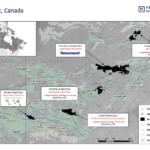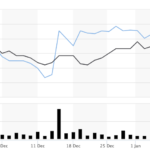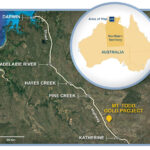Kenorland Minerals’ stock gain sways fickle investors
Also cited: Vista Gold; AMEX Exploration Eldorado Gold & Seabridge Gold
Canada’s Kenorland Minerals shares this (past) week notched a 20% gain in a picky, even swampish market for mining stocks.
So far, the gain and the thickest turnover of shares in 2 months for Kenorland KLD KLDCF shares is holding.
The gain comes after Kenorland swapped working interest in a Québec gold camp for a 4% royalty (net-smelter return) from now full-owner Sumitomo Metal. Details here please for Frotet Project agreement.
Is validation, a parking lot term used by mining CEOs, coming for Kenorland and dozens of other sub-$100 million mining wanna-bes? The ones forging maxi-ties to big names, that is? Kenorland stock data here please.
TCRs, I see early signs of life for long-suffering, obscure explorers and passed-over precious metal (and copper) developers.

More: another royalty-linked stock move, Vista Gold‘s VGZ $20 million stock-boosting agreement with Wheaton Australia, propelled volume and stock price markedly when unveiled in mid-December. Vista Gold stock data here please.

Still, Kenorland with $23 million in the bank, and some $4 million of securities, trades at a multiple of less than 2x the cash.
Vista Gold, with a guaranteed $20 million from Wheaton this year and a 9.4 million-ounce gold resource at Mt. Todd in Australia, sells for a little more than twice that.
“Minority interest in a joint venture is very tricky. We would have been required to keep up our spend of 20% of the budget while project expenditures ramp up significantly and as the minority (to Sumitomo), you are never really in control of the budgets and timeline. Exit strategy is also limited,” says Zach, with whom I have been exchanging material for approx. 7 years, even pre-Kenorland.
“With a royalty, we now have no further funding obligations and much more flexibility on how and when to monetize. Ultimately, we are exposed to a % of the total value of gold that comes out of the ground, regardless of underlying economics of any mining operation.”
Zach, who is 38, sees a “large value gap” between royalties on orphaned projects and royalties on assets that are producing or have real potential of becoming a mine.
“The real ones will command a huge premium, especially large royalties that are 2% to 3% NSR or greater, and even more so if the underlying asset is controlled by a major mining company.”

TCRs, a point to make here: I am ready to start stockpiling small companies that are getting attention from large miners. We saw the Alamos Gold-Orford Mining transaction this week; we saw the Dundee Precious Metals-Osino Resources one several weeks ago. Yes, the prices of the mini part of those mini-maxi equations are far less than they would be in a more appetizing market for unproven wanna-bes.
Yet regarding royalties, streams and outright corporate takeovers, and strategic stakes, such as $2.5 billion Eldorado Gold‘s ELD EGO $15 million CAD, or 9.9%, into Québec’s $100 million AMEX Exploration AMX AMXEF just this week, and as AMEX’s Victor Cantore in Montréal reminds me, these parking lot validations are starting to sway investors.
It is again this mini-maxi dynamic; see earlier The Calandra Report here please.
Fred Earnest of Vista Gold and I have been discussing the Mt. Todd project for 2 1/2 years now. We talked again today-Wednesday.
Thom Calandra is a writer and an investor. Research and material are meant as editorial opinion. He is not a professional investment adviser. Please do not consider his reporting as a recommendation to buy or sell securities.